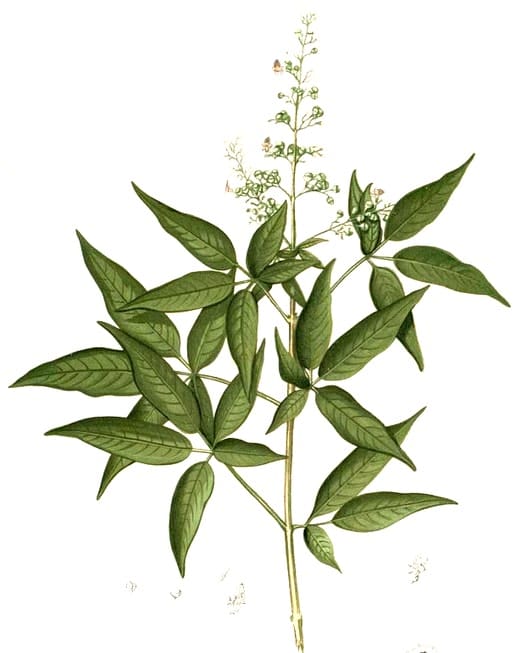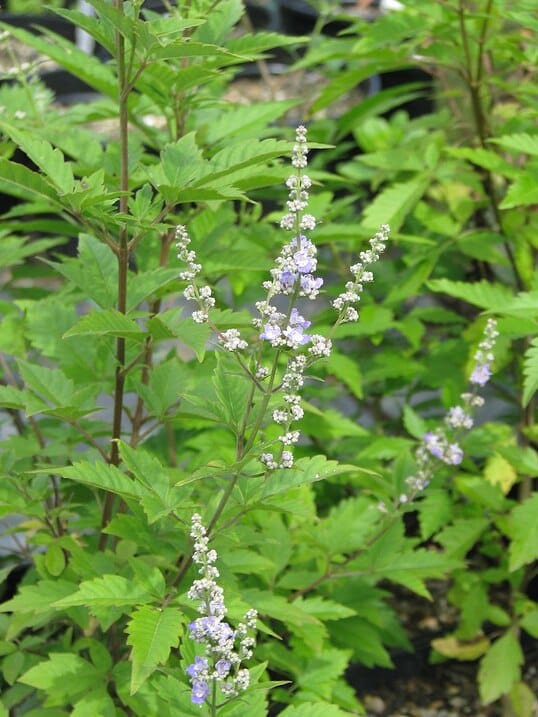Vitex negundo, Nirgundi, Man Jing Zi 蔓荆子
Five-leaved Chaste TreeNirgundi; Renuka (seed) (Ayurveda)
Man Jing Zi (TCM)
Tukhm-e-Sambhalu (Unani)
 Vitex negundo
Vitex negundoM. Blanco, Flora de Filipinas. (1875)
 Vitex negundo
Vitex negundo(Photo by peganum) (Wikimedia)
Botanical name:
Vitex spp:
Two main varieties are recognised:
- Vitex negundo (syn. V. negundo vat. incisa, V. incisa) (Blue flowers) (Ayurveda, Unani)
- V. trifolia, V. rotundifola (Pale blue flowers) (TCM)
However, some Indian sources have regarded them as synonymous.
Vitex agnus castus is related and used in the West.
Parts used:
Seed
Other parts are used including leaf, which is most used externally
Temperature & Taste:
Warm, dry (Cool in TCM). Bitter, Pungent
Classifications:
A. Clear Exterior Wind-Heat
Uses:
1. Clears Wind-Heat, Resists Poison: (TCM, Ayurveda)
-Fever, Common Cold
-acute cold or fever, especially with headache or eye pain (TCM)
-Intermittent Fever; Typhus Fever (leaf infusion, Ayurveda)
-red, sore, swollen, painful eyes from Wind-Heat or Liver heat (TCM, Ayurveda)
-Tinnitus (Ming Yi Bie Lu)
-itchiness of the skin; burning sensation
-protects from Epidemics, and against animal and vegetable toxins (Ayurveda)
2. Opens Obstructions, Clears Damp: (Ayurveda)
-Epigastric pain, indigestion
-swelling and inflammation of the Spleen or Liver
-Diarrhea (5–10 grams of powdered seed taken with Honey)
-used for Obesity (leaf juice)
3. Clears Wind-Damp, Eases Pain: (TCM, Ayurveda, Unani)
-stiffness, numbness, cramping, heaviness of the limbs (TCM)
-muscles and joint pain, rheumatic pain, Sciatica (Ayurveda, Unani)
-seed or leaf juice is used for this function
4. Moves the Blood, Promotes Menstruation: (Unani, Ayurveda)
-Amenorrhea
-regarded as useful to help women Conceive
-female diseases including Candida
5. Astringes Essence:
-lessens the amount of Semen (Ayurveda)
-Spermatorrhea, Noctural Emission
-in this respect it is used similarly to Agnus Castus
-‘Long-term use makes one feel happy and vigorous and keep one from aging’ (Shen Nong Ben Cao)
-tonifies Qi, gives luster and moisture to the hair (Ming Yi Bie Lu)
6. Kills Worms: (Unani, Ayurveda)
-auxilary medicines for Worms
-leaves also repel insects from clothes, books and foods etc when placed near them
7. Externally:
The leaves are generally used for external purposes
-oil prepared from the fresh leaves is applied to Scrofula (Ayurveda)
-leaves are used in baths for burning of the feet
-leaves are used topically for joint inflammation and acute rheumatism, sprains, contusions
-leaves are applied to swollen testicles (V. negundo)
-leaves are used in vapor baths
-dried leaves are smoked for headache and catarrh (Unani)
-leaf beaten with a little salt and applied to dental caries
-stems are used as a toothpick and tooth brush
-leaf extract boiled in coconut oil is applied to the forehead for Headache (Unani)
Dose:
Seeds in decoction: 3-9 grams (TCM)
Powder: 2–3 grams (Ayurveda)
Leaf Juice: 5 mls.
For topical application to pain, inflammations and swellings, the fresh leaves are laid in a pot and heated until as hot as they can be without burning, then applied directly to the place.
Comment:
1. Various Indian writers stated that few medicinal plants had as many virtues as Nirgundi.
2. Vitex negundo (Nirgundi) vs. Vitex trifolia (Man Jing Zi) of TCM.
When first compared, the use of the 2 species in the different systems appears quite different. Unani and Ayurveda view V. negundo as Warm and Dry, while in TCM. Vitex Man Jing Zi is classed as Cool. Further, in TCM it is primarily used (today) for Wind-Heat headache and eye diseases.
However, a very good passage appears in Bensky, taken from Records of Thoughtful Differentiation of Materia Medica:
‘ … all regard Viticis Fructus (man jing zi) as an acrid, cold herb; they do not know that its bitter warmth is greater than its acrid cold … which similarly imitates the Greater Yang’s quality of qi transformation: based in cold, but manifesting as heat, able to go from Yin out to Yang, and using Yang to transform Yin.’
Vitex negundo (Nirgundi) is also used for Opthalmic diseases in Unani medicine.
Various sources including Pharmacopoeia of India (Waring, 1868) stated the 2 species had similar or identical properties and covered them under the one heading, stating, however, that V. trifolia is the stronger of the two. So despite Bensky listing Vitex negundo as an adulterant for Vitex trifolia Man Jin Zi, we have considered them synonymous. The listing of it as an adulterant may be due to the former statement that V. trifolia is more potent.
3. Agnus Castus, used in the West, is closely related to Vitex nirgundi. However, due to the radically different uses in East and West, we have chosen to separate the entries. To compare Agnus Castus with Vitex nirgundi, see Agnus Castus.
Preparation:
1. Raw Vitex Man Jing Zi:
This is more dispersing and better to clear acute Wind-Heat with Headache and body ache.
2. Dry-fried Vitex Man Jing Zi:
This reduces the pungent, dispersing effect and is most used for Headache, with red, tearing eyes, and blurred vision.
3. Wine-prepared Vitex Man Jing Zi:
It was traditionally recommended to be steeped in wine, then dried.
Correctives:
1. Gum Arabic
2. Tragacanth (Unnai)
Substitutes:
1. Quince (Unani)
2. Vitex pseudo-negundo (syn. V. agnus-castus var. pseudo-negundo) is used as a substitute for V. negundo
Main Combinations:
1. Headache and Dizziness from Wind-Heat, Vitex trifolia (Man Jing Zi) with Tribulus seed (TCM)
2. Acute Headache with red and sore Eyes, Vitex trifolia Man Jing Zi with Chrysanthemum Ju Hua (TCM)
3. Female tonic for Health and beauty, Vitex neguno (Nirgundi) with Betel nut (boiled in water), Catechu, Chlorophytum, Withania, Ginger, Long Pepper, Cumin, Clove, Cinnamon, Mesua, Plumbago, Iron bhasma, Micha bhasma, Red Coral (as in Nari Kalyan Pak of Ayurveda)
4. Indigestion, fatigue, Vitex neguno (Nirgundi) with Raisins, Cinnamon, Cardamon, Clove, Long Pepper, Plumbago (made into a medicated wine with Sugar and Honey) (Ayurveda)
5. Obesity, Vitex negundo leaf juice (5mls) with a little Lemon jucie added
6. Pain, inflammation and obstruction of the Spleen, Vitex negundo (Nirgundi) with White Pepper, Caper root-bark, Gum Ammoniac (as in Tablets of Capers of Unani Medicine)
7. Pain, spasms, stiffness or number of the limbs, Vitex trifolia (Man Jing Zi) with Saposhnikovia Fang Feng, Gentiana Qin Jiao, Chaenomelas Mu Gua (TCM)
8. Sciatica, Guggulu taken with decoction of Vitex negundo (Ayurveda)
9. Rheumatoid Arthritis, equal parts of Ginger, Garlic and Vitex negnudo as a decoction. (Ayurveda)
10. Facial Paralysis, Hemiplegia, Tremor and Arthralgia, combine Vitex neguno (Nirgundi) with Guggulu, Triphala, Asafetida, Calamus, Plumbago, and Long Pepper (as in Majun Jograj Gugul of Unani Medicine)
11. Vaginitis and Candida, Vitex negundo with Triphala, Rose, Lesser Cardamon, Turmeric
12. Burning sensation, Vitex negundo wth Sandalwood and Peppermint
Major Formulas:
Majun Jograj Gugul (Unani Medicine)
Nari Kalyan Pak (Ayurveda)
Tablets of Capers (Unani Medicine)
Cautions:
1. Excess or long-term use damages the Kidney Yin and reduces Sperm and causes sexual debility (Ayurveda). Anti-androgenic effects have been shown in the seeds of V. negundo.
2. Full doses or excess use may cause Headache (Ayurveda)
3. Use cautiously in those with a weak Stomach
